Announcement
Collapse
No announcement yet.
What Became Of #19 Cleveland Street? Conflicting Information
Collapse
X
-
Thread Summation
Hi Krinoid.Originally posted by Krinoid View PostI don't get it or I am missing something ,wger enow TOday is the exact site of the original 19 Cleaveland street?
Mark
I think you're asking where the exact site of #19 Cleveland Street is and what's on it today? That's exactly what we were working out in the course of this thread.
But if you want it in a nutshell-
According to the maps kindly provided by Colin and the general consensus of thread participants, the site of #19 is opposite the house once lived in by Charles Dickens at #22 Cleveland Street. (#22 still stands.)
The original house at #19 was demolished in the 1890's.
The building that replaced it seems to have been demolished in the 1920's to make way for an expansion of the Middlesex Hospital.
That part of the hospital was in turn demolished to make way for a new building venture. Today the site of #19 is merely part of a huge empty lot. (If you go to Post #1 there are Google Maps photos of this empty lot.)
That empty lot was supposed to have been built over again as part of an ambitious new residential and commercial venture called "NoHo Square", but due to the poor economy the project seems to be in limbo.
Hope that helps.
Best regards,
Archaic
Leave a comment:
-
Er, what?Originally posted by Krinoid View PostI don't get it or I am missing something ,wger enow TOday is the exact site of the original 19 Cleaveland street?
Mark
Leave a comment:
-
I don't get it or I am missing something ,wger enow TOday is the exact site of the original 19 Cleaveland street?
Mark
Leave a comment:
-
Hi John.
Is 'Upper Ogle Street' anywhere near 'Mincing Lane'?

Archaic
Leave a comment:
-
Not forgetting nearby 'Upper Ogle Street' and 'Ogle Mews'.Originally posted by Archaic View PostThanks Colin, those are great.
I was just thinking, weren't the names of some of the boys just priceless?
"Newlove" and "Thickbroom"
...A late-night talk show host/comedian's dream.
Best regards,
Archaic
Fnarf. Fnarf.
Leave a comment:
-
Video: Dickens Home & Cleveland Street Workhouse
Here's a nice little BBC on the Cleveland Street Workhouse that was aired in February of this year, when the historic workhouse was threatened with demolition. It shows the very close proximity of the Dickens home and the Cleveland Street Workhouse.
This video was posted on YouTube by author Philip Hutchinson (GuildfordGhost), so thanks very much Phil!
Video: http://www.youtube.com/watch?v=RkJsO...eature=related
Best regards,
Archaic
Leave a comment:
-
Thanks Colin, those are great.
I was just thinking, weren't the names of some of the boys just priceless?
"Newlove" and "Thickbroom"
...A late-night talk show host/comedian's dream.
Best regards,
Archaic
Leave a comment:
-
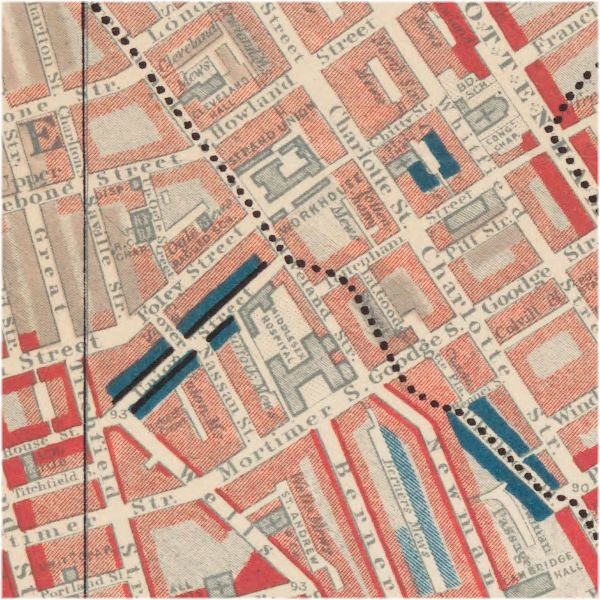
Charles Booth's Map Descriptive of London Poverty, 1889-1891: Cleveland Street, Parish of St. Marylebone / Parish of St. Pancras
Leave a comment:
-
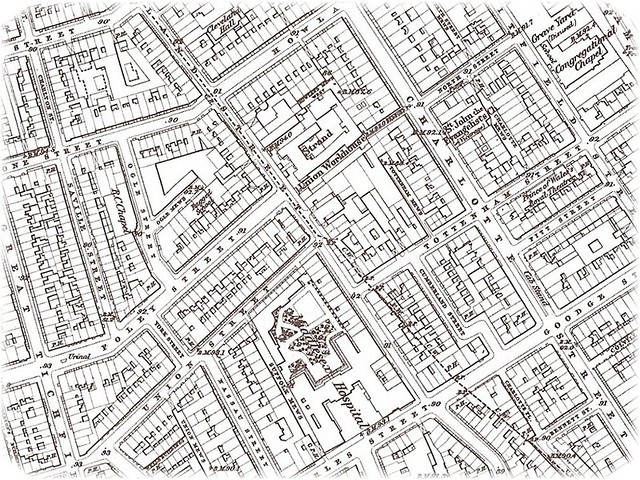
1870 Ordnance Survey: Cleveland Street, Parish of St. Marylebone / Parish of St. Pancras (Click Image, to Enlarge in flickr)

1894 Ordnance Survey: Cleveland Street, Parish of St. Marylebone / Parish of St. Pancras (Click Image, to Enlarge in flickr)
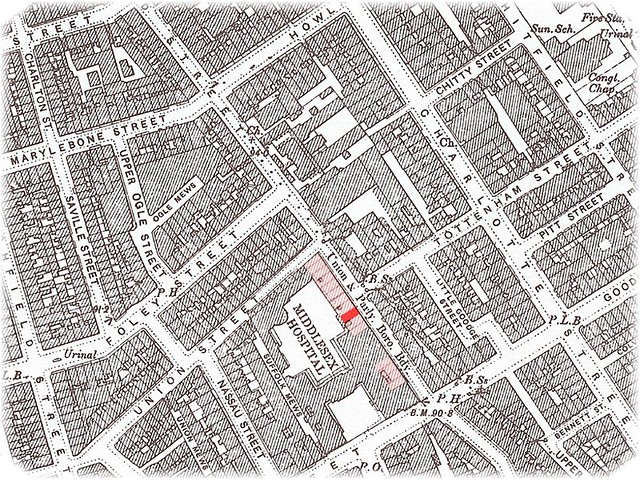
(Hybrid) 1870/1894 Ordnance Survey: Cleveland Street, Parish of St. Marylebone / Parish of St. Pancras (Click Image, to Enlarge in flickr)
Red: 19 Cleveland Street, Parish of St. Marylebone
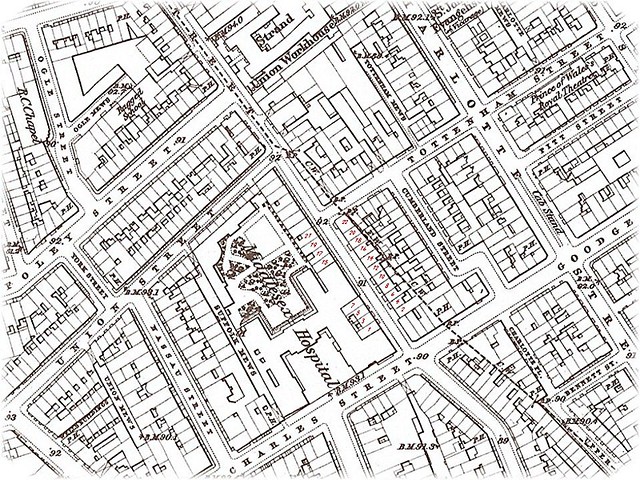
1870 Ordnance Survey (A Closer View, Along with some Applicable House Numbers): Cleveland Street, Parish of St. Marylebone / Parish of St. Pancras (Click Image, to Enlarge in flickr)
19 Cleveland Street, Parish of St. Marylebone, along with several adjacent properties, was replaced by an extension of the Middlesex Hospital, by 1894.
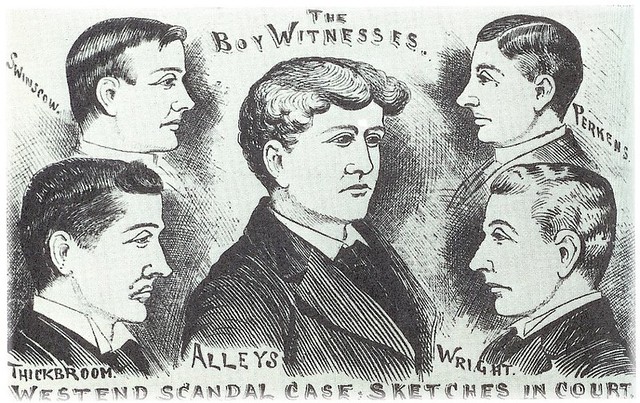
Witnesses: Cleveland Street Scandal (Click Image, to Enlarge in flickr)
Each of these young men was paid by Charles Hammond to 'entertain' a male clientele, at 19 Cleveland Street, Parish of St. Marylebone.
Swinscow was the one that 'spilled the beans', so to speak. He, along with Perkens, Thickbroom, and Wright, was an employee of the Central Telegraph Office; and, was recruited for Hammond, by fellow employee, Henry Newlove.
Alleys (Allies (?)) was the star witness.
He was fired for theft, from his position as a waiter, at the Marlborough Club, in Pall Mall. Lord Arthur Somerset, who was a prominent member of the club, then introduced him to Charles Hammond, ... at which point he actually assumed residence at #19, along with Hammond's sidekick, George Veck.
Leave a comment:
-
Labouchere Mentions Location of #19 Cleveland Street In Parliament
Hi Mike. Thanks very much for your comment; I'm glad you're enjoying the thread. And thanks again to everyone for their participation!
I found an interesting remark regarding the location of #19 Cleveland Street. What makes it even more interesting is that it was spoken in Parliament by Henry Labouchere, after whom the critical 1885 Labouchere Amendment was named.
Officially known as 'Section 11 of the Criminal Law Amendment Act', the Labouchere Amendment made it possible to prosecute men for the crime of "gross indecency" - a term never actually defined. Prior to this amendment specific proofs of sodomy were required for the criminal prosecution of homosexuals.
It's fascinating that an individual's behavior could be classed as a 'crime' without even providing a legal definition of that behavior! This of course made it easier to convict on suspicion rather than on actual evidence. Even in the Old Bailey records of the 1700's, the act of sodomy had to be 'proved' by proving two specific facts before a person could be found guilty. It seems incredibly today that the extremely vague Labouchere Amendment stood as law from 1885 until 1967.
(Oscar Wilde was convicted of 'Gross Indecency' under this law and served a prison term of two years at hard labor, which completely broke his health.)
The attachment below is a passage from the Parliamentary Session of February 28, 1890, in which Labouchere indignantly describes the location of #19 Cleveland Street as standing "nearly opposite Middlesex Hospital". Apparently the fact that a homosexual brothel was located in Fitzrovia made its existence even more shocking.
(He of course refers to the older section of the hospital which fronted on Mortimer Street, not the newer section built in the 1920's which encompassed the site that had been occupied by #19 Cleveland Street.)
Best regards,
Archaic
Leave a comment:
-
Thanks for that Colin.
Do you believe that #19 was demolished as a direct result of the notoriety it had attracted in the scandal?
If so, do you believe it was demolished at the behest of the government, who had reason to prefer that the Cleveland Street Scandal fade from public memory as speedily as possible?
I remember reading somewhere that #19 was "removed" from what I believe was termed "the Land Registry" in the early 1890's, but the implication seemed to be that this was a deliberate ploy to make it appear to be gone when in fact it had merely been renumbered. Not sure where I read that. Maybe it was mentioned in one of the links I posted above; I'll check.
It seemed to me that the most obvious reason for a building to disappear from the records was that it had been torn down, so what you are saying makes sense.
If a building is torn down, does its empty lot still retain the same address number?
I wonder if the site of #19 was rebuilt sometime after 1894, only to be demolished again in the 1920's for the hospital, or if was simply left as an empty lot for upwards of 30 years?
Hmm, even as an empty lot, I bet it wouldn't have done the local housing prices any favors. Cleveland Street must have suddenly become a very unfashionable address.
Cleveland Street must have suddenly become a very unfashionable address.
Thanks,
Archaic
Leave a comment:
-
I missed this particular post, Archaic.Originally posted by Archaic View PostI had originally believed that #19 Cleveland Street was demolished sometime between the 1890's and the early 1920's when the Middlesex Hospital was built, but if that's true it would indicate that Cleveland Street wasn't renumbered in the wake of the scandal, as multiple sources have claimed.
I wonder if the people who claim #19 and/or its immediate vicinity were renumbered after the Cleveland Street Scandal simply have their dates wrong, and the "renumbering" occurred at some point before 1889, when this section of the old Norfolk Street was renamed and renumbered as an extension of Cleveland Street?
Charles Dickens lived at #10 Norfolk Street twice; during part of his childhood, starting in 1815, and again in 1829. This would indicate that Norfolk Street was renamed and renumbered as Cleveland Street sometime between 1830 and 1889, before the Cleveland Street Scandal.
If #22 Cleveland Street was #10 Norfolk Street in Dickens' day, then #19 Cleveland Street was probably something like #7 Norfolk Street.
Maybe that's the origin of the 'renumbering' claims, in which case the numbering change occurred before the Cleveland Street Scandal and was not part of some official government 'damage control' designed to erase the notorious #19. (Even if its demolition was.)
So was the author of 'The London Compendium: Exploring the Hidden Metropolis' simply mistaken when he wrote in 2003 “A Victorian brothel at 19 Cleveland Street (since renumbered #18 and rebuilt)…” ? Because #18 still stands.
19 Cleveland Street was demolished before 1894.
I don't believe that any sort of renumbering occurred prior thereto, but I will have to re-visit the issue.
Originally posted by Rob Clack View PostSpot on.
Leave a comment:
-
"...and the ever lovely Rob Clack."
He forgot "sweet"
Thanks, Rob. I knew you'd have a few good images up your sleeve.
And Colin, thanks for all the info & photos; much appreciated.
Best regards,
Archaic
Leave a comment:

Leave a comment: